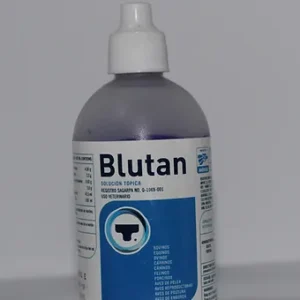Enfloxil
Enfloxil is a veterinary medication that contains enrofloxacin as the active ingredient. It is part of the fluoroquinolone class of antibiotics, which are used to treat a wide variety of bacterial infections in animals, including livestock, dogs, cats, and horses.
Key Points About Enfloxil:
Active Ingredient:
Enrofloxacin: Enrofloxacin is a broad-spectrum antibiotic that is effective against both Gram-negative and Gram-positive bacteria. It works by inhibiting bacterial DNA synthesis, which prevents the bacteria from replicating and leads to their death.
Available Forms:
Enfloxil 5%: Typically used for treating smaller animals such as dogs and cats.
Enfloxil 10%: Commonly used for larger animals like livestock (cattle, pigs) and horses, and sometimes in severe cases of infection in smaller animals.
Uses:
Enfloxil is primarily used to treat bacterial infections in animals, including:
Respiratory Infections: Pneumonia, bronchitis, and other respiratory diseases caused by bacterial pathogens.
Urinary Tract Infections (UTIs): Effective in treating infections in the urinary tract.
Skin and Soft Tissue Infections: For example, abscesses, wounds, and infections of the skin.
Gastrointestinal Infections: Bacterial enteritis and other digestive system infections.
Reproductive System Infections: It can also be used for infections in the reproductive organs.
Mastitis: Particularly in cattle, Enfloxil can be used to treat bacterial mastitis.
Dosage and Administration:
Enfloxil 5% and Enfloxil 10% are usually available in injectable form or as oral solutions.
Administration Route:
Injectable Form: Usually administered intramuscularly (IM) or subcutaneously (SC), depending on the type of animal and the condition being treated.
Oral Form: Enfloxil is also available in oral tablet or solution form for easier administration in smaller animals.
Dosage: The dosage depends on the weight of the animal and the severity of the infection. Generally, the dosage ranges from 2.5 mg to 10 mg/kg of body weight per day. It is important to follow the veterinarian’s prescription for accurate dosing.
Indications:
Dogs and Cats: Enfloxil is commonly used to treat infections such as respiratory, urinary tract, and skin infections.
Livestock (Cattle, Pigs, Poultry): Used in the treatment of respiratory diseases like pneumonia, mastitis, and other bacterial infections that affect these animals.
Horses: It can be used in horses to treat infections like bacterial respiratory diseases and soft tissue infections.
Benefits:
Broad-Spectrum Efficacy: Enrofloxacin is highly effective against a wide range of bacteria, making it versatile for various infections.
Fast-Acting: It starts working quickly to control infections.
Low Toxicity: Enrofloxacin is generally safe when used at the recommended doses.
Good Tissue Penetration: The drug penetrates well into tissues, making it effective for deep-seated infections.
Side Effects and Risks:
Gastrointestinal Issues: Diarrhea, vomiting, and reduced appetite can occur, particularly in smaller animals like dogs and cats.
Joint and Cartilage Damage: Prolonged use of fluoroquinolones like enrofloxacin has been linked to joint and cartilage issues, particularly in young animals and growing puppies.
Neurological Side Effects: Rarely, seizures or nervous system issues can occur, especially in animals with pre-existing conditions.
Allergic Reactions: Some animals may have an allergic reaction, which could include swelling, hives, and difficulty breathing.
Precautions:
Not for Use in Young or Growing Animals: Enrofloxacin should be avoided in young animals (especially dogs under 12 months of age) due to the risk of joint and cartilage damage.
Not Recommended in Pregnant or Lactating Animals: There is limited data on the safety of enrofloxacin in pregnant or lactating animals.
Avoid Overuse: Overuse of antibiotics like enrofloxacin can lead to antibiotic resistance, which reduces the drug’s effectiveness over time.
Contraindications:
Animals with Seizures: Enrofloxacin can increase the risk of seizures in animals with pre-existing neurological conditions.
Animals Allergic to Fluoroquinolones: Any animals with a known allergy to fluoroquinolones should avoid using Enfloxil.
Growing Animals: As mentioned, avoid use in young or rapidly growing animals.
10. Drug Interactions:
Antacids or Calcium Supplements: These can reduce the absorption of enrofloxacin, making it less effective.
Other Antibiotics: Avoid concurrent use with other antibiotics unless directed by a veterinarian, as this can lead to reduced effectiveness or increased side effects.
Withdrawal Periods for Livestock:
Meat: If Enfloxil is used in animals intended for food production, there is a required withdrawal period before the meat can be processed for human consumption. This withdrawal period varies by country and species, so it is important to follow local regulations.
Milk: When using in dairy cattle, the withdrawal period for milk should also be observed to prevent antibiotic residues in milk products.
Conclusion:
Enfloxil (with 5% and 10% formulations) is a potent, broad-spectrum antibiotic used in veterinary medicine to treat various bacterial infections in animals. Its primary active ingredient, enrofloxacin, works effectively against many bacterial pathogens that cause respiratory, urinary, skin, and gastrointestinal infections.
While highly effective, it should be used cautiously, especially in young or growing animals, and only under the guidance of a veterinarian due to potential side effects and the risk of antibiotic resistance.





Reviews
There are no reviews yet.